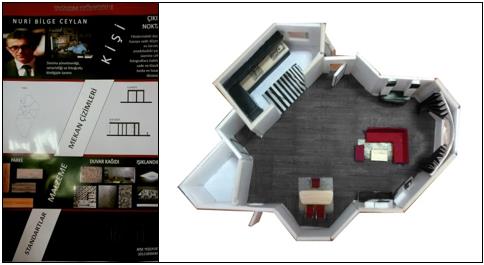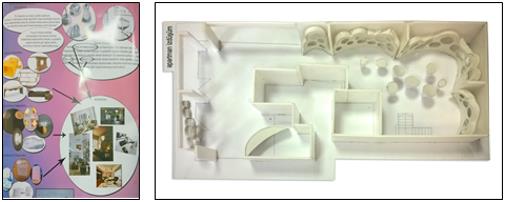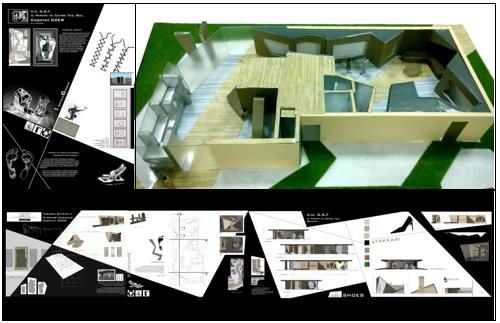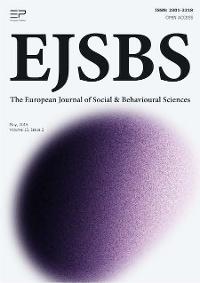Abstract
In addition to its indispensable role in presentation, graphic design could be designated as a powerful instrument especially in architectural education for students to develop a design idea at the very beginning of the process. That's why, mood boards provide a useful tool with which students respond their perceptions on the design problem and develop ideas about it. This paper discusses the role of graphics in design education as not only it is commonly accepted, a presentation tool; but also as rarely applied, a part of design process. The discussion is held through comparison of usage of art of graphics both on final presentations and on ‘mood boards’ linking the end of the process with the beginning. With these ideas in mind, the authors would like to share their experiences and define the contributions of usage of mood boards in 2013-2014 semester of the design studios in Department of Interior Architecture and Environmental Design at Akdeniz University FFA.
Keywords: Art of graphics, design education, mood board
Introduction
Designating graphic design as a vital tool in presentation part of architecture is a widely accepted notion not only in architectural practice but also in architectural education. Most of professional architects use graphic design as means of communication, which display their ideas and aims of an already completed design. Moreover, as Gurel and Basa (2004, p. 193) conveyed there is also “a consensus for the necessity of an ideally finalized graphical presentation of a design project” in design studios; a tendency releted with “sets and systems of values that are hidden in the agenda of a design studio and its evaluation system”.
Nevertheless, these attitudes ignore the potentials of art of graphics within design process and constrain its usage by presentation. Indeed, graphic design could be a powerful tool especially in architectural education, for students to develop a design idea at the very beginning of the process.
Problem Statement
The idea of presenting design in most pleasant and effective way forces designers to use the realm of visual language and art of graphics. Besides, visual representations such as sketches, drawings and virtual models are requirements as vital means of communication in the domain of architecture profession.
For that reason, most of the architects are well equipped with graphical skills, but they don’t consider them as neither technical nor theoretical part of their professional knowledge but as a part of their professional abilities. Hence, they dislocated graphical knowledge in presentation phase instead of the conceptual development process of an architectural design project. In other words, architects do not utilize their graphical skills as tool for design but as tool for displaying the already designed.
Research Questions
Although graphic design is designated as a powerful tool for presentation both in architectural education and in professional life, the authors would like to examine the possibility of wider use of art of graphics in conceptual development of a design project. Hence the this study questions if it is possible to integrate art of graphics within the design process implicitly by creating a demand for it on early stages of the design process?
Purpose of the Study
The purpose of this study is to show that utilizing art of graphics could be a productive side-tool in concept development stage of design process. In order to achieve this goal, it is important to understand the process of design and sequences of actions in a designing process.
Nevertheless, it is not easy to understand the nature of design since it has many implicit personalized manners in decision making processes. Besides, the difficulty of understanding the design process lies partly in the fact that the design knowledge is tacit in nature, too. As in Polanyi’s (1966, p. 4) famous statement “we can know more than we can tell” in design education. On the other hand, the real difficulty lies in the fact that design process could not be linearly defined, because the sequences of actions in the process realized by many implicit inspirations and feedbacks. Because of these characteristics, it is defined as black box model for decision making. Black box of design is open to various inspirations and interactions, especially in the early stages of design which have many ambiguities (Bayazıt, 1994). The art of graphics could be a productive tool, implicitly serving students at the fuzzy beginning of the black box. Mood boards provide a useful medium for students to experience working with the graphical skills at the early stages of the design process.
The purpose of this paper is to present the results of practice of mood boards in the early phases of design education, experienced in 2013-2014 semester of Akdeniz University FFA, Interior Architecture and Environmental Design Department.
Research Methods
In order to show that utilizing art of graphics could be a productive side-tool, the authors decided to change the sequence of it in the design process from final to beginning stage. They decided to give students an assignment which lead them to articulate their ideas by utilizing their graphical skills but at the same time, not detached from the design process and help it as being a part of it.
Hence, they asked students to make a mood board for reflecting their early ideas on the given design problem in a pleasant graphical way. The medium was limited as A2 foam board but the technique is totally free. Mood boards need not be expensive or time consuming to construct. They could be constructed with found or drawn images, diagrams, photographs, sample textures or colors, even sometimes 3D objects. The graphical arrangement of the collage of these images and objects were open to all techniques, but the only obligation is to represent inspirations, emotions, feelings, insights, in other words the mood evoked by the design assignment.
In doing so, the authors intended to create both a demand for usage of graphical skills at the early stages of the design process and courage students to reflect their stage of thoughts and insights on the given design assignment by using their graphical skills rather than presenting an already finished design.
Findings
Although “mood boards offer a visual and sensorial channel of communication” (McDonagh and Denton: 2005), the only aim of using mood board is not presentation of the inspirations. Instead, it can take an active role assisting problem finding and also problem solving in design process. Especially in design education, mood boards have important role in “developing students’ ability to articulate their thinking” about the given assignment (Garner & McDonagh-Philp, 2001). Many students experience great difficulty in the early phases of design process when they had to create a concept in the fuzzy sphere of inspirations, informations and functional necessities. They often get lost in concept-finding and preferred skipping the phase, then, tended to use more stereotypical proposals and analytic design strategies, which are risk free but infertile in terms of creativity.
With the intension of assisting students to handle the fuzzy early steps of the design process more conveniently, the authors experimented a new studio curriculum in 2013-2014 spring semester. The following examples are drawn from the undergrad design studios in Department of Interior Architecture and Environmental Design at Akdeniz University FFA. As explained earlier, students were asked to prepare a mood board reflecting their inspirations on the given design problem in a graphical way. The construction of the mood board was open to all techniques. They prepared various kinds of mood boards using mix media of found or drawn images, diagrams, photographs, etc. and presented these on the first jury at the second week of the semester.
It’s observed on this jury that some of the students considered mood board assignment as meaningless extra work and poorly undertaken this phase of the design process. But on the following days, it appeared that students who handled mood board assignment successfully were faster in concept development and the following stages of the design studio. Apparently, they were more rapidly adopting their minds in the studio curriculum in comparison to students who did not do the same. These students finalized their projects earlier than the others and had more time to spend on their final models and drawings. Hence, their final presentations were more developed not only in design issues but also in terms of graphical quality of the presentation.

The authors also observed some visible links such as consistencies and continuties in final and preliminary jury materials of the students’ who undertook mood board assignment truly. In order to reveal these links, the authors compared the jury materials of all 41 students and find out three types of consistensies between mood boards, final designs and final presentations. These were in form of graphical relations such as color, shape or layout. The following three examples were selected to picture these links.


As presented in the first example (figure 1), most common graphical link the authors encountered is about color preferences sustained in different stages of design during the process. The given example is showing the color preferences for the design of the mood board, which were perpetuated for sixteen weeks until the end of the semester. The student even used exactly the same color tones in final design for furniture, curtains, and kitchen countertop as shown in the model (figure 1 right). There is also a non-dominant connection between the black and white striped rug and the striped graphical layout of the mood board. Second example (figure 2) is meaningful for its consistency in shapes between the first and the final juries. The elliptical forms which are the most significant elements in final interior proposal, preferred by the student both on walls and in furniture design; and they were also dominant graphical forms used in the mood board presented in the first jury at the second week. The third example displays more noteworthy features in terms of continuity. As seen in the figure 3 (upper left) the mood board’s layout was designed significantly in an angular form. The two intersecting axis with an arbitrary angle, divided the board in four asymmetrical sections in form of triangles. In the following phases of design process, this preliminary angular layout had became a core for the main proposal of design. Likewise, the main space is divided by an angular axis (figure 3 upper right) transformed into a broken line which constituted the main spine of the interior arrangement. Later, he used the same concept for his final presentation, together with the preliminary color preferences of for his mood board.
Conclusion
Mood board is not a common tool for design education in interior design and architecture. However, its usage in studios has obvious contributions not only for motivation and communication but also creating a demand for art of graphics and assisting students during the development of a design concept at the fuzzy beginning of the studio process.
Primary advantage of using mood boards is about adopting students in studio curriculum. As it is observed, the students who truly did mood board assignment, rapidly and successfully got over the concept development phases which were considered the most confusing and time consuming stages of design. By the help of the motivation and time gained, these students finalized their projects earlier than the others and had more time to spend on their final models and drawings.
Besides, mood boards are particularly beneficial for first and second year students whose analytical and creative skills are not developed enough to guide themselves in the design process. While these students were trying to respond the given mood board task, they were also unfittingly presenting their implicit early inspirations for the design problem. Hence, mood boards can provide direction and insight to their subconscious design process by indirectly integrating art of graphics within the design process. In this way, students who undertaken mood boards vigorously had taken the advantage of finding out their early design ideas concealed in form, color and layout preferences of the mood board’s graphical arrangement. This would create a sustainable consistency between various phases, linking the beginning to final phases of the design process as well.
Lastly, while the examples are all drawn from interior architecture studios the authors believe that same could be observed in many other areas of design education especially in architectural education.
Acknowledgements
The author(s) declare that there is no conflict of interest.
References
Bayazıt, N. (1994). Endüstri Ürünlerinde ve Mimarlıkta Tasarlama Metodlarına Giriş. Literatür Yayınevi: İstanbul.
Garner, S., & McDonagh-Philp, D., (2001). Problem Interpretation and Resolution via Visual Stimuli: The Use of ‘Mood Boards’ in Design Education. The Journal of Art and Design Education, 20(1), 57-64.
Gürel, M., & Basa, İ. (2004). The Status of Graphical Presentation in Interior/Architectural Design Education. International Journal of Art & Design Education, 23(2), 192-206.
McDonagh, D., & Denton, H., (2005). Exploring the degree to which individual students share a common perception of specific mood boards: observations relating to teaching, learning and team-based design. Design Studies, 26(1), 35-53.
Polanyi, M. (1966). The Tacit Dimension. Chicago: University of Chicago Press.
Copyright information

This work is licensed under a Creative Commons Attribution-NonCommercial-NoDerivatives 4.0 International License.


